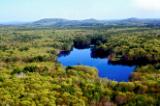Mount Agamenticus by Beginning with Habitat
Beginning with Habitat’s Mount Agamenticus Focus Area extends from York Pond in Eliot northeast through the Tatnic Hills area in Wells. The Focus Area includes rugged terrain, several lakes and ponds, and numerous small wetlands that together comprise the largest contiguous block of lightly developed land in southern York County and one of the largest remaining areas of undeveloped forest in coastal New England.
The 692-foot-high Mount Agamenticus is the most outstanding natural feature in the area, both topographically and ecologically. Other prominent physical features are Horse Hill, Second and Third Hills, Chick’s Brook watershed, Chase’s Pond, Folly Pond, Middle Pond, Bell Marsh, Warren Pond, Welch’s Pond, Round Pond, and York Pond.
The area’s numerous upland and wetland areas are ecologically significant because they host plant and animal species that are living at the northernmost limit of their geographic ranges. In Maine, for example, at least three animal and 20 plant species occur only in this extreme southern portion of the state. Many additional species found in the Focus Area occur only sparingly farther northward. Natural communities reflect this pattern as well. For example, the Atlantic white cedar swamp, hemlock-hardwood pocket swamp, and pitch-pine bog that occur in this area are all restricted to southern Maine. The only remaining intact chestnut-oak woodland community in the entire state extends north from Mt. Agamenticus through Third Hill.
The Focus Area has one of the richest concentrations of vernal pool habitat in the state, supporting state-listed Blanding’s turtles and spotted turtles in concentrations rarely encountered elsewhere.
Of the 21 rare plant species known to occur in the Mount Agamenticus area, 14 are considered rare in Maine because the state represents the northeastern limit of their range. They are much more common to the south and west. The Mount Agamenticus area, in particular, is the northern limit for a few of these species, such as large beak-rush (Rhynchospora macrostachya) and flowering dogwood (Cornus florida).
Two rare plant species found in the Focus Area—wild leek (Allium tricoccum) and alga-like pondweed (Potamogeton confervoides)—do not reach the edge of their geographic range in Maine. However, wild leek is uncommon in Maine because it lives only in nutrient-enriched hardwood forests, while alga-like pondweed occurs only in shallow, soft-water ponds.





